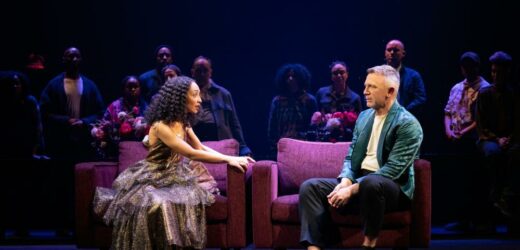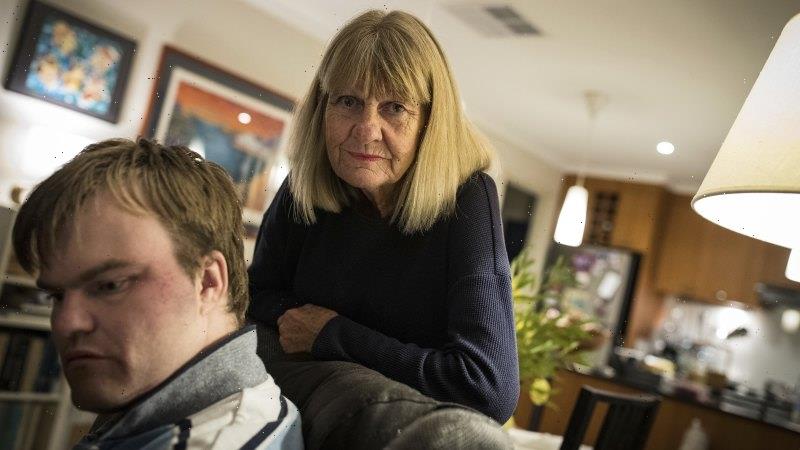A bare set. Actors making stew on stage. An abundance of hand-held fog machines. Vague contemporary setting and costumes. A generally spooky atmosphere. Put all the ingredients together and you have director Sam Gold’s revival of “Macbeth.”
It’s also the exact recipe for quite a few existing productions of “Macbeth.” It is in no way original to focus, as a curtain speech tells us here, on the witches and what we might call the generally creepy vibe of the play. Under all the fog (and there is a lot of it), there isn’t much substance in this production, which clearly prioritizes an aesthetic and a mood over acting, coherence and Shakespeare’s text.
The last show Gold (“Fun Home”) directed on Broadway, “King Lear” (starring Glenda Jackson), was an endless cacophony of confounding choices. His “Macbeth” is better, but only marginally. This time he has a very clear, albeit simplistic directorial vision (spooky!), so the production has some focus, and he has cut the text down to two hours and 20 minutes, so things move fairly quickly. That said, it is hard to find much else to praise.
The production boasts an all-star cast — Daniel Craig (Macbeth) and Ruth Negga (Lady Macbeth) plus theater favorites Maria Dizzia (Lady Macduff) and Amber Gray (Banquo), to name just a few — but every single actor is in their own play. No one is on the same page stylistically; scene partners barely connect with each other; there is no trace of any unifying dialect. The only piece of direction they all seemed to be given is to stand center stage, unmoving, for every monologue and deliver it to the balconies, chin and eyes up.
Some actors rise above the lack of direction, including Dizzia, Michael Patrick Thorton (as Lennox) and Paul Lazar (playing Duncan in a can’t-believe-we-are-still-doing-this-in-2022 fat suit). The majority of the cast, though, is adrift. Gray and Grantham Coleman (Macduff) give unremarkable performances. Asia Kate Dillon (Malcolm), who is nonbinary and uses they/them pronouns — as does Malcolm in this production — is particularly flat and struggles with the character’s important speeches.
Craig has some strong moments but does not capture the transformation of Macbeth into a power-hungry tyrant. He and Gold make no attempt to draw any parallels between Macbeth and current political leaders — a lost opportunity, especially since, as we are told in the curtain speech, the play was commissioned by a king who had strong thoughts about usurpers and violent leaders. While Craig’s performance is imperfect, it is Negga who is the bigger disappointment. She falls flat, giving a generic performance. Lady Macbeth is one of Shakespeare’s best characters, but Negga, far from the center of the play, barely leaves a mark.
Together, she and Craig have no spark. Gold has them awkwardly make out in their first scenes, but after that, they stay far apart from each other, making their lack of chemistry more apparent. The marketing, showing Negga’s face within a crumbling marble bust of Craig’s, feels like a lie; this production has no interest in exploring their relationship. The marriage of the Macbeths is the core of this play, but Gold ignores it.
The program includes a note about the minimalist approach, a plot synopsis and an infographic explaining the various groupings of the characters. For an audience unfamiliar with the play, the summary is essential to understand several of the plot points of this production — like when Lady Macbeth kills herself, since the staging is brief and unclear. Gold’s cutting of the text may make things move faster, but it also makes some of the plot events appear random, reduces the play to a string of murders and deaths and does not give space for the emotional shifts to play out.
Likewise, the double and triple casting, standard practice for Shakespeare productions, add confusion even for those who know the play. For instance, the witches become Lady Macduff, her child, the doctor, and in one instance, Phillip James Brannon goes directly from playing a witch to Ross. With no costume changes to signal character shifts, the audience is given no clues or assistance in navigating these shifts.
The costume design by Suttirat Larlarb includes beautiful pieces (especially for the leading couple in the Duncan dinner scene) but also some head-scratching garments, like the silk pajamas (occasionally paired with leather riding boots and a hunting sweater) that Craig wears for more than half the show. Because there is functionally no set, Jane Cox’s lights do a great deal of work, often making striking visuals (especially one tableau in that perfectly-designed dinner scene early on). The fight sequences (by “violence director” David Leong) are striking in a different way, notable for how poorly and bizarrely they are choreographed; you’d think Craig, a former James Bond, might have lent a hand.
The most defining design element of this production is the fog. It’s such a major part of this production, it is more the star than Craig. The fog does very effectively establish the mood and is often used to great effect, but it’s also overused. Fog does not a production make.
Gold tries to cover over everything with fog, unaware of all that is missing. Most painful is his and the cast’s lack of appreciation for the poetry of the piece. There’s no sense of rhythm, no relishing of Shakespeare’s grammatical acrobatics. The cast merely marches through the lines, clopping along to the next stabbing and sweep of fog. Gold seems more interested in the stylistic scene transitions than the scenes themselves, leaving the production to feel like little more than a hollow puff of smoke. Alas, poor William, your work deserves better. Let’s hope that after this, Gold gives Shakespeare a break.
Source: Read Full Article


